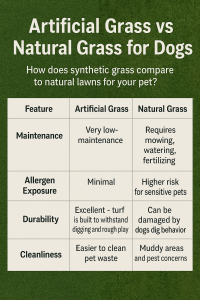Artificial grass has become a popular choice for many pet owners looking for a low-maintenance alternative to traditional grass lawns. However, one common concern remains: is artificial grass toxic to dogs? The good news is that most modern turf products are non-toxic, durable, and specifically designed for dogs.
In this article, we’ll explore the safety of artificial turf for pets, address common risks, provide expert opinions, and offer practical tips to create a safe and comfortable outdoor space for your furry friend.
Are today’s turf products safe for dogs?
Most artificial grass sold today is made from non-toxic, pet-safe materials like polyethylene or polypropylene, similar to what’s used in food containers. These materials don’t pose health risks and are often labeled lead-free and pet-friendly.
In fact, artificial grass is designed to be durable, weather-resistant, and easy to clean—making it a great choice for pet owners who want a yard that’s both safe and comfortable for dogs.
Concerns about older or lower-quality artificial grass
While modern artificial turf is generally safe for pets, not all products meet the same standards. Some older synthetic turf options included crumb rubber infill made from recycled tires, which could contain harmful chemicals.
Lower-end products may also have chemical treatments, including flame retardants or herbicides. That’s why it’s critical to select pet-friendly artificial grass specifically marketed as safe for dogs, especially when choosing the right pet turf system..
For those comparing costs, it’s helpful to know exactly how much does pet turf cost so you can choose a quality product within budget.
Turf materials and infill
Artificial grass systems include not just the turf itself but also the installation of a pet turf system. infill, which helps the turf fibers stand upright and supports drainage. Depending on the material, the infill can impact both comfort and safety for your dog.
- Crumb rubber: Now largely avoided due to chemical concerns.
- Silica sand: A common, safe infill.
- Zeolite or organic infills (like coconut husk or cork): Ideal for pet turf due to odor control and cooling properties.
Unlike natural grass, which may attract bugs and allergens, synthetic options can reduce exposure to irritants, making them more pet-friendly.
Common risks and misconceptions
Despite being safe for pets, there are still a few risks and myths surrounding artificial turf that dog owners should understand.
1. Allergic reactions or ingestion
Some dogs chew on artificial turf or eat pieces of infill, which could cause minor digestive issues. Be sure to choose pet-friendly turf with non-toxic materials and monitor your furry friend during early exposure.
2. Turf can get too hot
Yes, artificial grass can get hot in the summer, especially under direct sunlight. This may cause discomfort or paw burns. To keep your dog safe, rinse the turf with a focus on choosing turf safe for dogs. hose before use or install shaded areas. Keep dogs hydrated and avoid playtime during peak heat.
3. Chemical exposure
Some concerns arise from potential chemical treatments. However, high-quality artificial lawn is often a great alternative to real grass for pet owners. products are often antimicrobial and don’t require herbicides. Look for labels like “safe for pets” or “pet-friendly artificial grass.”
Best practices for safe pet turf use
To maximize safety and hygiene, follow these maintenance and usage tips:
- Hose down the turf regularly to remove pet waste and debris.
- Use turf cleaner products designed for artificial pet turf.
- Make sure the drainage system works properly to prevent puddles and bacteria buildup.
- Choose antimicrobial infill to reduce odor and germs.
- During hot months, prevent overheating by keeping your furry companion hydrated and cool.
Artificial grass vs natural grass for dogs
How does synthetic grass compare to natural lawns for your pet?
|
Feature |
Artificial Grass |
Natural Grass |
| Maintenance | Very low-maintenance | Requires mowing, watering, fertilizing |
| Allergen Exposure | Minimal | Higher risk for sensitive pets |
| Durability | Excellent – turf is built to withstand digging and rough play | Can be damaged by dogs dig behavior |
| Cleanliness | Easier to clean pet waste | Muddy areas and pest concerns |

For homeowners evaluating long-term use, check out the best artificial grass for dogs how long does artificial turf last when exposed to dog urine. and how long does a pet turf last to make an informed decision.
Pros and cons of artificial grass for dogs
Pros:
- No mud or fleas
- Low maintenance
- Looks green year-round
- Durability and long life span
Cons:
- Can get too hot
- Not biodegradable
- Requires proper installation for drainage
If you’re wondering how much does fake grass cost, it varies depending on size, materials, and infill type.
Final thoughts
So, is artificial grass toxic to dogs? In general, no—especially when you choose pet turf from reputable providers. With the right turf system, proper drainage, and pet-safe materials, artificial turf is a great investment for any dog owner seeking a safe and comfortable outdoor space for their furry friend.
Be sure to:
- Choose pet-friendly artificial grass.
- Avoid old or rubber-based infill.
- Keep the artificial lawn clean.
- Use a hose to cool it down in hot weather.
With these precautions, you can create a beautiful, dog-friendly turf that won’t harm your dog and stays lush year-round, unlike natural grass.